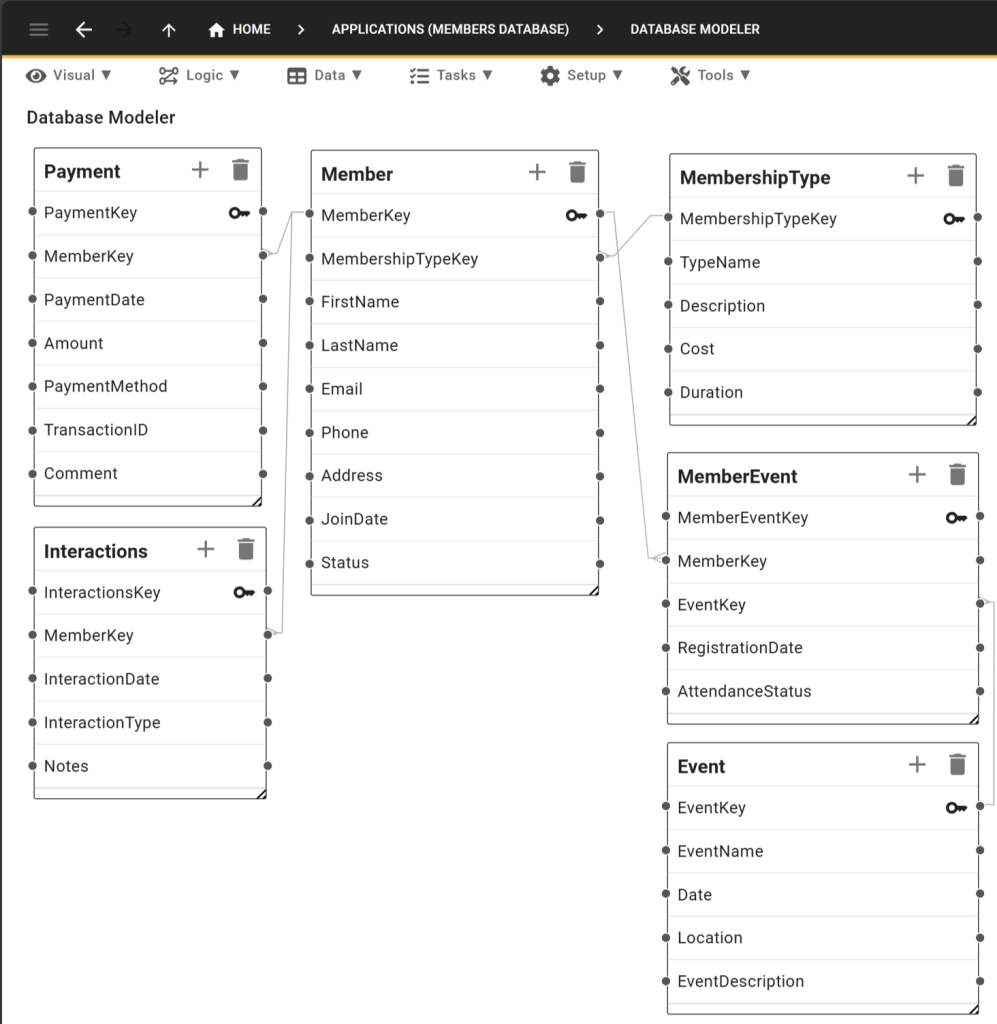Create a Relational Database In 3 Steps
Learn How to Create a Relational Database From Scratch
Relational databases are the backbone of web apps. Relational databases, such as MySQL, MS SQL Server, or PostgreSQL, store the data that web apps process. Building a relational database is often the first step in application development, as the database structure defines how the application can process information.
Having a well-defined relational database schema also helps speak about your web app to other developers and explain its purpose.
Let’s learn how to create a relational database in just 3 steps.
What Is a Relational Database?
A relational database solves a fundamental problem that every business has: businesses need to store data. The data that businesses store is often related: for example, orders are related to customers and products.
A database stores data, and it stores information about the relationships between those data. That’s why it is called a relational database.
Here is a simple example of a database that stores patient information, for example.
The lines between the entities explain how each entity is related to each other: a patient, for example, has appointments, which generates bills.

Relational databases rely on database management systems (DBMS). DBMS’ is the software that allows a user to communicate or query a relational database.
The basic features of a DBMS are:
1. Creation of the database structure, i.e. tables, relationships, fields, and data types.
2. A way to enter, modify, update, and delete data, usually in Structure Query Language or SQL.
3. A way to retrieve data: a user must be able to retrieve data, or subsets of data, through queries.
Here is another example of a relational database, but this time, shown as a database model with tables and fields. This database stores data about members:

To find more relational database templates, visit our resources here.
Relational Database Templates
How to Create a Relational Database in 3 Steps
Five is an online database builder designed to make creating a relational database much faster. It makes SQL simple.
Creating a relational database with Five won’t be entirely effortless (but we have plenty of free templates available), but it will be significantly easier than spending 60+ hours learning various coding frameworks and languages.
In addition, with Five, your database is fully customizable and adjustable, exactly tailored to your needs.
With Five, you can
1. Set up a database in minutes, and
2. Create a login-protected, user-friendly interface that works well on the web and on any device, such as desktop, tablet, or mobile.
3. You can also easily import your existing data from Excel, Google Sheets, or CSV files, allowing you to get started quickly.
Five also offers the flexibility to create custom business logic with code, generate PDF documents, and visualize your data through custom charts and dashboards.
Get free access to Five here and start building a relational database.
Five has a team of experts ready to assist you with your development and customizations. So, if you ever feel like you’re in need of a new dashboard or a form field, don’t worry, our expert developers are here to help. And yes, we promise not to charge you an arm and a leg or leave you with a system that only we understand!
Step 1: Create your Entity-Relationship Diagram
Start by compiling a complete list of all the data that your database is supposed to store.
A simple shortcut is to use Chat-GPT or any other AI Large-Language Model and ask the question “which would you include in a [insert name of your database] database?”.
Next, ask Chat-GPT to explain the relationships between the tables.
The desired result of step 1 is to create an Entity-Relationship Diagram (ERD). If you are struggling with this step, start with a simplified representation of your database as shown above. Then break it down step-by-step into tables, database fields, and relationships.
Step 2: Start Building Your Tables
Building your tables can be done in traditional SQL using a SQL GUI such as MySQL Workbench, or you can create modern relational database builders such as Five.
Five gives you a simple point-and-click database builder for MySQL. All you have to do is create fields, and assign your field a data type (such as a string, float, integer, or binary), and define the relationships in point-and-click.
One big advantage of Five is that it automatically creates Primary Keys and Foreign Keys. These keys uniquely identify records and are used to build relationships between tables.
Watch this video to better understand how to build tables in Five:
Step 3: Launching Your Database to the Cloud
Once your database is ready and well-defined, you can start populating it with data.
Five lets you upload CSV files straight into your SQL database. Simply match the columns of your CSV to the fields in your database, and you can import the data straight into your database table.
Alternatively, you can build a simple web-based database graphical user interface (GUI) with Five. This interface can have forms for adding or editing records inside your database. You can also add charts to visualize data in your database, or generate PDF reports, such as quotations or invoices that use data from your relational database.
To learn more, follow one of our code-along guides.
Relational Databases in Five: Key Features
A Customizable and Hosted SQL Database
Five gives you a fully customizable, cloud-hosted SQL database. You have full control of your database, its tables, fields, and relationships.
Searchable and Online
Our relational database is searchable and hosted online. It can be accessed by any device and at any time.
Login Protected and Secure
Securing data is paramount for organizations of all sizes: Five comes with a pre-built authentication feature that adds a login screen to your application. Only registered users with valid credentials can view or edit data stored in your database. You can also add multi-factor authentication for extra security.
Simple-to-Use Forms
We then created the form that our users can interact with, again using just a few clicks. Forms enable us to store or retrieve information from our database.
Easily Add MFA Authentication
To further enhance the security of your database, you can add multi-factor authentication to your clinic management application.
Generate Documents
Five lets you generate documents straight from inside the application. For example, you can easily create bills, invoices, or appointment reminders, and even automatically send them out.
Get Started with Five Today
To build your relational database with Five, sign up for free access and start the process. If you need assistance, visit our forum and get help from our application development experts.
By following the steps mentioned above, you can create robust and scalable relational software tailored to your needs.


